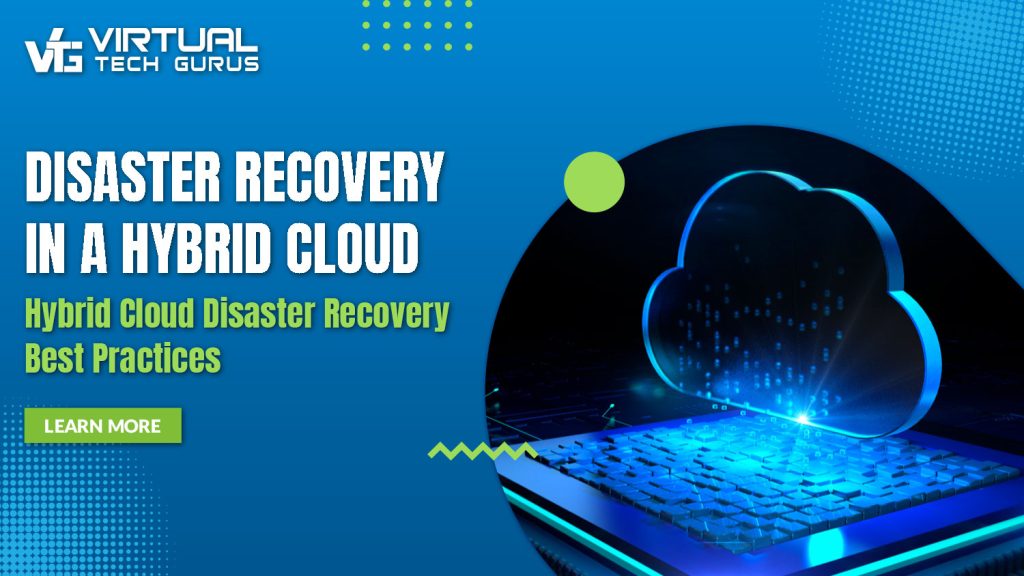
Disaster Recovery in a Hybrid Cloud Environment
A hybrid cloud environment is one that combines on-premises infrastructure with public cloud services. This type of environment can offer a number of benefits, such as increased flexibility, scalability, and cost savings. However, it can also introduce additional complexity and challenges, such as increased risk of data breaches and difficulty managing disaster recovery.
Why is disaster recovery important in a hybrid cloud environment?
Disaster recovery is important in any IT environment, but it is especially important in a hybrid cloud environment. This is because hybrid cloud environments can be more complex and difficult to manage than traditional on-premises environments. Additionally, hybrid cloud environments can be more vulnerable to cyberattacks.
Challenges of disaster recovery in a hybrid cloud environment
There are a number of challenges that organizations face when implementing disaster recovery in a hybrid cloud environment. Some of the most common challenges include:
- Complexity: Hybrid cloud environments can be complex, with multiple different components and technologies. This can make it difficult to develop and implement a disaster recovery plan that covers all of the potential risks.
- Data sovereignty: Organizations need to comply with data sovereignty regulations, which can make it difficult to replicate data to the cloud.
- Security: Hybrid cloud environments can be more vulnerable to cyberattacks. This is because they have a larger attack surface and can be more difficult to secure.
- Cost: Disaster recovery solutions can be expensive, especially for hybrid cloud environments.
Best practices for disaster recovery in a hybrid cloud environment
There are a number of best practices that organizations can follow to implement disaster recovery in a hybrid cloud environment. Some of the most important best practices include:
- Develop a comprehensive disaster recovery plan: The disaster recovery plan should identify all of the potential risks to the hybrid cloud environment and outline the steps that will be taken to mitigate those risks. The plan should also include a process for testing and updating the plan on a regular basis.
- Replicate data to the cloud: Replicating data to the cloud is one of the most important things that organizations can do to protect their data from disaster. Organizations can use a variety of different tools and technologies to replicate data to the cloud, including cloud-based backup and disaster recovery solutions.
- Use security tools and technologies: Organizations should use a variety of security tools and technologies to protect their hybrid cloud environment from cyberattacks. These tools and technologies should include firewalls, intrusion detection systems, and intrusion prevention systems.
- Test the disaster recovery plan regularly: It is important to test the disaster recovery plan on a regular basis to ensure that it is working properly. This will help organizations to identify any potential problems and make necessary adjustments before a disaster occurs.
Disaster recovery solutions for hybrid cloud environments
There are a number of different disaster recovery solutions available for hybrid cloud environments. Some of the most popular solutions include:
- Cloud-based backup and disaster recovery solutions: Cloud-based backup and disaster recovery solutions can be used to replicate data to the cloud and restore data in the event of a disaster.
- Disaster recovery as a service (DRaaS): DRaaS is a managed service that provides organizations with a complete disaster recovery solution. DRaaS providers can help organizations to replicate data to the cloud, test their disaster recovery plans, and recover from a disaster.
- On-premises disaster recovery solutions: On-premises disaster recovery solutions can be used to replicate data to another on-premises data center. This can be a good option for organizations that need to maintain control over their data and meet data sovereignty requirements.
Conclusion
Disaster recovery is an important part of any IT strategy, but it is especially important in a hybrid cloud environment. Organizations should carefully consider the challenges and best practices for disaster recovery in a hybrid cloud environment when developing and implementing their disaster recovery plan.
Here are some additional tips for disaster recovery in a hybrid cloud environment:
- Use a cloud-based disaster recovery solution to replicate data to the cloud and restore data in the event of a disaster.
- Test your disaster recovery plan regularly to ensure that it is working properly.
- Use security tools and technologies to protect your hybrid cloud environment from cyberattacks.
- Work with disaster recovery as a service (DRaaS) provider to help you develop and implement a comprehensive disaster recovery plan and manage your disaster recovery environment.
How Can VTG help?
VTG offers an extensive portfolio of Data Based Consulting services in the Infrastructure Disaster Recovery space, including:
- Assessments around Disaster Recovery, Data Protection, Storage management and planning, Compute infrastructure, and FinOps
- Implementation of solutions/remediations from assessments or other requirements definitions
- Migration to new or updated solutions
- Monitoring, Alerting, and Management of infrastructure elements
- Data Based Consulting as a Service to manage and update infrastructure elements
Are you prepared for the unexpected? Disaster recovery in a hybrid cloud environment is your safety net. Our experts can guide you through the intricacies of disaster recovery strategies in the hybrid cloud landscape. Contact us today for practical insights and tailored solutions.
